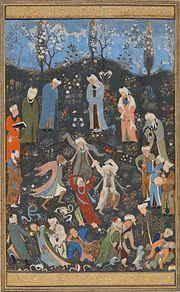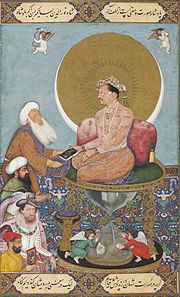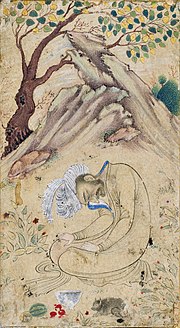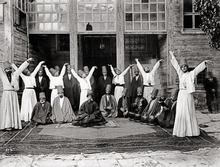A | B | C | D | E | F | G | H | CH | I | J | K | L | M | N | O | P | Q | R | S | T | U | V | W | X | Y | Z | 0 | 1 | 2 | 3 | 4 | 5 | 6 | 7 | 8 | 9
| Part of a series on Islam Sufism |
|---|
|
|
| Part of a series on |
| Islam |
|---|
 |
Sufism (Arabic: الصُّوفِيَّة aṣ-ṣūfiyya), also known as Tasawwuf[1] (التَّصَوُّف at-taṣawwuf), is a mystic body of religious practice, found mainly within Sunni Islam but also within Shia Islam, which is characterized by a focus on Islamic spirituality, ritualism, asceticism and esotericism.[2][3][4][5][6] It has been variously defined as "Islamic mysticism",[7][8][9] "the mystical expression of Islamic faith",[10] "the inward dimension of Islam",[11][12] "the phenomenon of mysticism within Islam",[13][14] the "main manifestation and the most important and central crystallization" of mystical practice in Islam,[15][16] and "the interiorization and intensification of Islamic faith and practice".[17]
Practitioners of Sufism are referred to as "Sufis" (from صُوفِيّ, ṣūfīy),[13] and historically typically belonged to "orders" known as tariqa (pl. ṭuruq) – congregations formed around a grand wali who would be the last in a chain of successive teachers linking back to Muhammad.[18]
Sufism emerged early on in Islamic history,[13] partly as a reaction against the worldliness of the early Umayyad Caliphate (661–750) and mainly under the tutelage of Hasan Al-Basri.[19][page needed][20] Although Sufis were opposed to dry legalism, they strictly observed Islamic law and belonged to various schools of Islamic jurisprudence and theology.[21] Although the overwhelming majority of Sufis, both pre-modern and modern, remain adherents of Sunni Islam, certain strands of Sufi thought transferred over to the ambits of Shia Islam during the late medieval period.[22] This particularly happened after the Safavid conversion of Iran under the concept of Irfan.[22] Important focuses of Sufi worship include dhikr, the practice of remembrance of God.[23] Sufis also played an important role in spreading Islam through their missionary and educational activities.[21]
Despite a relative decline of Sufi orders in the modern era and attacks from revivalist Islamic movement (such as the Salafis and Wahhabis), Sufism has continued to play an important role in the Islamic world, especially in the neo-traditionalist strand of Sunni Islam.[24][25] It has also influenced various forms of spirituality in the West and generated lots of academic interest.[26][27][28] However, some recent scholarship has challenged the Western understanding of Sufism as orientalist in nature.[29][30]
Definitions
The Arabic word tasawwuf (lit. 'being or becoming a Sufi'), generally translated as Sufism, is commonly defined by Western authors as Islamic mysticism.[31][32] The Arabic term Sufi has been used in Islamic literature with a wide range of meanings, by both proponents and opponents of Sufism.[31] Classical Sufi texts, which stressed certain teachings and practices of the Quran and the sunnah (exemplary teachings and practices of the Islamic prophet Muhammad), gave definitions of tasawwuf that described ethical and spiritual goals[note 1] and functioned as teaching tools for their attainment. Many other terms that described particular spiritual qualities and roles were used instead in more practical contexts.[31][32]
Some modern scholars have used other definitions of Sufism such as "intensification of Islamic faith and practice"[31] and "process of realizing ethical and spiritual ideals".[32]
The term Sufism was originally introduced into European languages in the 18th century by Orientalist scholars, who viewed it mainly as an intellectual doctrine and literary tradition at variance with what they saw as sterile monotheism of Islam. In modern scholarly usage the term serves to describe a wide range of social, cultural, political and religious phenomena associated with Sufis.[32]
Etymology
The original meaning of sufi seems to have been "one who wears wool (ṣūf)", and the Encyclopaedia of Islam calls other etymological hypotheses "untenable".[13][31] Woolen clothes were traditionally associated with ascetics and mystics.[13] Al-Qushayri and Ibn Khaldun both rejected all possibilities other than ṣūf on linguistic grounds.[33]
Another explanation traces the lexical root of the word to ṣafā (صفاء), which in Arabic means "purity", and in this context another similar idea of tasawwuf as considered in Islam is tazkiyah (تزكية, meaning: self-purification), which is also widely used in Sufism. These two explanations were combined by the Sufi al-Rudhabari (d. 322 AH), who said, "The Sufi is the one who wears wool on top of purity."[34][35]
Others have suggested that the word comes from the term Ahl al-Ṣuffa ("the people of the suffah or the bench"), who were a group of impoverished companions of Muhammad who held regular gatherings of dhikr, one of the most prominent companion among them was Abu Huraira. These men and women who sat at al-Masjid an-Nabawi are considered by some to be the first Sufis.[36][37]
History
Origins
Modern academics and scholars have rejected early Orientalist theories asserting a non-Islamic, or "Aryan" origin of Sufism.[21] The current consensus is that it emerged in the Hejaz, and that Sufism has existed as a practice of Muslims from the earliest days of Islam, even predating some sectarian divides.[38][better source needed]
Sufi orders are based on the bayah (Arabic: بَيْعَة, lit. 'pledge') that was given to Muhammad by his Ṣahabah. By pledging allegiance to Muhammad, the Sahabah had committed themselves to the service of God.[39][40][41]Ernst, Carl W. (2003). "Tasawwuf ". Encyclopedia of Islam and the Muslim World.[full citation needed]
Verily, those who give Bay'âh (pledge) to you (O Muhammad) they are giving Bay'âh (pledge) to Allâh. The Hand of Allâh is over their hands. Then whosoever breaks his pledge, breaks it only to his own harm, and whosoever fulfils what he has covenanted with Allâh, He will bestow on him a great reward. —
Sufis believe that by giving bayʿah (pledging allegiance) to a legitimate Sufi Shaykh, one is pledging allegiance to Muhammad; therefore, a spiritual connection between the seeker and Muhammad is established. It is through Muhammad that Sufis aim to learn about, understand and connect with God.[42] Ali is regarded as one of the major figures amongst the Sahaba who have directly pledged allegiance to Muhammad, and Sufis maintain that through Ali, knowledge about Muhammad and a connection with Muhammad may be attained. Such a concept may be understood by the hadith, which Sufis regard to be authentic, in which Muhammad said, "I am the city of knowledge, and Ali is its gate."[43] Eminent Sufis such as Ali Hujwiri refer to Ali as having a very high ranking in Tasawwuf. Furthermore, Junayd of Baghdad regarded Ali as Sheikh of the principals and practices of Tasawwuf.[44]
Historian Jonathan A.C. Brown notes that during the lifetime of Muhammad, some companions were more inclined than others to "intensive devotion, pious abstemiousness and pondering the divine mysteries" more than Islam required, such as Abu Dharr al-Ghifari. Hasan al-Basri, a tabi', is considered a "founding figure" in the "science of purifying the heart".[45]
Practitioners of Sufism hold that in its early stages of development Sufism effectively referred to nothing more than the internalization of Islam.[46] According to one perspective, it is directly from the Qur'an, constantly recited, meditated, and experienced, that Sufism proceeded, in its origin and its development.[47] Other practitioners have held that Sufism is the strict emulation of the way of Muhammad, through which the heart's connection to the Divine is strengthened.[48]
Some contend that Sufism developed from people like Bayazid Bastami, who, in his utmost reverence to the sunnah, refused to eat a watermelon because he did not find any proof that Muhammad ever ate it.[49][50] According to the late medieval mystic, the Persian poet Jami,[51] Abd-Allah ibn Muhammad ibn al-Hanafiyyah (died c. 716) was the first person to be called a "Sufi".[33] The term also had a strong connection with Kufa, with three of the earliest scholars to be called by the term being Abu Hashim al-Kufi, Jabir ibn Hayyan and Abdak al-Sufi.[52] Later individuals included Hatim al-Attar, from Basra, and Al-Junayd al-Baghdadi.[52] Others, such as Al-Harith al-Muhasibi and Sari al-Saqati, were not known as Sufis during their lifetimes, but later came to be identified as such.[52]
Important contributions in writing are attributed to Uwais al-Qarani, Hasan of Basra, Harith al-Muhasibi, Abu Nasr as-Sarraj and Said ibn al-Musayyib.[53] Ruwaym, from the second generation of Sufis in Baghdad, was also an influential early figure,[54][55] as was Junayd of Baghdad; a number of early practitioners of Sufism were disciples of one of the two.[56]
Sufi orders
Historically, Sufis have often belonged to "orders" known as tariqa (pl. ṭuruq) – congregations formed around a grand master wali who will trace their teaching through a chain of successive teachers back to the Islamic prophet Muhammad.[18]
Within the Sufi tradition, the formation of the orders did not immediately produce lineages of master and disciple. There are few examples before the eleventh century of complete lineages going back to the Prophet Muhammad. Yet the symbolic importance of these lineages was immense: they provided a channel to divine authority through master-disciple chains. It was through such chains of masters and disciples that spiritual power and blessings were transmitted to both general and special devotees.[57]
These orders meet for spiritual sessions (majalis) in meeting places known as zawiyas, khanqahs or tekke.[58]
They strive for ihsan (perfection of worship), as detailed in a hadith: "Ihsan is to worship Allah as if you see Him; if you can't see Him, surely He sees you."[59] Sufis regard Muhammad as al-Insān al-Kāmil, the complete human who personifies the attributes of Absolute Reality,[60] and view him as their ultimate spiritual guide.[61]
Sufi orders trace most of their original precepts from Muhammad through Ali ibn Abi Talib,[62] with the notable exception of the Naqshbandi order, who trace their original precepts to Muhammad through Abu Bakr.[63] However, it was not necessary to formally belong to a tariqa.[64] In the Medieval period, Sufism was almost equal to Islam in general and not limited to specific orders.[65](p24)
Sufism had a long history already before the subsequent institutionalization of Sufi teachings into devotional orders (tariqa, pl. tarîqât) in the early Middle Ages.[66] The term tariqa is used for a school or order of Sufism, or especially for the mystical teaching and spiritual practices of such an order with the aim of seeking ḥaqīqah (ultimate truth). A tariqa has a murshid (guide) who plays the role of leader or spiritual director. The members or followers of a tariqa are known as murīdīn (singular murīd), meaning "desirous", viz. "desiring the knowledge of knowing God and loving God".[67]
Over the years, Sufi orders have influenced and been adopted by various Shi'i movements, especially Isma'ilism, which led to the Safaviyya order's conversion to Shia Islam from Sunni Islam and the spread of Twelverism throughout Iran.[68]
Prominent tariqa include the Ba 'Alawiyya, Badawiyya, Bektashi, Burhaniyya, Chishti, Khalwati, Kubrawiya, Madariyya, Mevlevi, Muridiyya, Naqshbandi, Nimatullahi, Qadiriyya, Qalandariyya, Rahmaniyya, Rifa'i, Safavid, Senussi, Shadhili, Suhrawardiyya, Tijaniyyah, Uwaisi and Zahabiya orders.
Sufism as an Islamic discipline

Existing in both Sunni and Shia Islam, Sufism is not a distinct sect, as is sometimes erroneously assumed, but a method of approaching or a way of understanding the religion, which strives to take the regular practice of the religion to the "supererogatory level" through simultaneously "fulfilling ... religious duties"[13] and finding a "way and a means of striking a root through the 'narrow gate' in the depth of the soul out into the domain of the pure arid unimprisonable Spirit which itself opens out on to the Divinity."[9] Academic studies of Sufism confirm that Sufism, as a separate tradition from Islam apart from so-called pure Islam, is frequently a product of Western orientalism and modern Islamic fundamentalists.[69]
As a mystic and ascetic aspect of Islam, it is considered as the part of Islamic teaching that deals with the purification of the inner self. By focusing on the more spiritual aspects of religion, Sufis strive to obtain direct experience of God by making use of "intuitive and emotional faculties" that one must be trained to use.[66] Tasawwuf is regarded as a science of the soul that has always been an integral part of Orthodox Islam.[70] In his Al-Risala al-Safadiyya, ibn Taymiyyah describes the Sufis as those who belong to the path of the Sunna and represent it in their teachings and writings.[citation needed]
Ibn Taymiyya's Sufi inclinations and his reverence for Sufis like Abdul-Qadir Gilani can also be seen in his hundred-page commentary on Futuh al-ghayb, covering only five of the seventy-eight sermons of the book, but showing that he considered tasawwuf essential within the life of the Islamic community.[citation needed]
In his commentary, Ibn Taymiyya stresses that the primacy of the sharia forms the soundest tradition in tasawwuf, and to argue this point he lists over a dozen early masters, as well as more contemporary shaykhs like his fellow Hanbalis, al-Ansari al-Harawi and Abdul-Qadir, and the latter's own shaykh, Hammad al-Dabbas the upright. He cites the early shaykhs (shuyukh al-salaf) such as Al-Fuḍayl ibn ‘Iyāḍ, Ibrahim ibn Adham, Ma`ruf al-Karkhi, Sirri Saqti, Junayd of Baghdad, and others of the early teachers, as well as Abdul-Qadir Gilani, Hammad, Abu al-Bayan and others of the later masters— that they do not permit the followers of the Sufi path to depart from the divinely legislated command and prohibition.[citation needed]
Al-Ghazali narrates in Al-Munqidh min al-dalal:
The vicissitudes of life, family affairs and financial constraints engulfed my life and deprived me of the congenial solitude. The heavy odds confronted me and provided me with few moments for my pursuits. This state of affairs lasted for ten years, but whenever I had some spare and congenial moments I resorted to my intrinsic proclivity. During these turbulent years, numerous astonishing and indescribable secrets of life were unveiled to me. I was convinced that the group of Aulia (holy mystics) is the only truthful group who follow the right path, display best conduct and surpass all sages in their wisdom and insight. They derive all their overt or covert behaviour from the illumining guidance of the holy Prophet, the only guidance worth quest and pursuit.[71]
Formalization of doctrine
In the eleventh-century, Sufism, which had previously been a less "codified" trend in Islamic piety, began to be "ordered and crystallized" into orders which have continued until the present day. All these orders were founded by a major Islamic scholar, and some of the largest and most widespread included the Suhrawardiyya (after Abu al-Najib Suhrawardi d. 1166), the Rifa'iyya (after Ahmed al-Rifa'i d. 1182), the Chishtiyya (after Moinuddin Chishti d. 1236), the Shadiliyya (after Abul Hasan ash-Shadhili d. 1258), the Hamadaniyyah (after Sayyid Ali Hamadani d. 1384, the Naqshbandiyya (after Baha-ud-Din Naqshband Bukhari d. 1389).[72] Contrary to popular perception in the West,[73] however, neither the founders of these orders nor their followers ever considered themselves to be anything other than orthodox Sunni Muslims,[73] and in fact all of these orders were attached to one of the four orthodox legal schools of Sunni Islam.[74] Thus, the Qadiriyya order was Hanbali, with its founder, Abdul-Qadir Gilani, being a renowned jurist; the Chishtiyya was Hanafi; the Shadiliyya order was Maliki; and the Naqshbandiyya order was Hanafi.[75] Thus, it is precisely because it is historically proven that "many of the most eminent defenders of Islamic orthodoxy, such as Abdul-Qadir Gilani, Ghazali, and the Sultan Ṣalāḥ ad-Dīn (Saladin) were connected with Sufism"[76] that the popular studies of writers like Idries Shah are continuously disregarded by scholars as conveying the fallacious image that "Sufism" is somehow distinct from "Islam."[77][76][78] Nile Green has observed that, in the Middle Ages, Sufism more or less was Islam.[65](p24)
Growth of influenceedit

Historically, Sufism became "an incredibly important part of Islam" and "one of the most widespread and omnipresent aspects of Muslim life" in Islamic civilization from the early medieval period onwards,[79][better source needed] when it began to permeate nearly all major aspects of Sunni Islamic life in regions stretching from India and Iraq to the Balkans and Senegal.[80][better source needed]
The rise of Islamic civilization coincides strongly with the spread of Sufi philosophy in Islam. The spread of Sufism has been considered a definitive factor in the spread of Islam, and in the creation of integrally Islamic cultures, especially in Africa[81] and Asia. The Senussi tribes of Libya and the Sudan are one of the strongest adherents of Sufism. Sufi poets and philosophers such as Khoja Akhmet Yassawi, Rumi, and Attar of Nishapur (c. 1145 – c. 1221) greatly enhanced the spread of Islamic culture in Anatolia, Central Asia, and South Asia.[82][83] Sufism also played a role in creating and propagating the culture of the Ottoman world,[84] and in resisting European imperialism in North Africa and South Asia.[85]

Between the 13th and 16th centuries, Sufism produced a flourishing intellectual culture throughout the Islamic world, a "Renaissance" whose physical artifacts survive.[citation needed] In many places a person or group would endow a waqf to maintain a lodge (known variously as a zawiya, khanqah, or tekke) to provide a gathering place for Sufi adepts, as well as lodging for itinerant seekers of knowledge. The same system of endowments could also pay for a complex of buildings, such as that surrounding the Süleymaniye Mosque in Istanbul, including a lodge for Sufi seekers, a hospice with kitchens where these seekers could serve the poor and/or complete a period of initiation, a library, and other structures. No important domain in the civilization of Islam remained unaffected by Sufism in this period.[88]
Modern eraedit
Opposition to Sufi teachers and orders from more literalist and legalist strains of Islam existed in various forms throughout Islamic history. It took on a particularly violent form in the 18th century with the emergence of the Wahhabi movement.[89]
Around the turn of the 20th century, Sufi rituals and doctrines also came under sustained criticism from modernist Islamic reformers, liberal nationalists, and, some decades later, socialist movements in the Muslim world. Sufi orders were accused of fostering popular superstitions, resisting modern intellectual attitudes, and standing in the way of progressive reforms. Ideological attacks on Sufism were reinforced by agrarian and educational reforms, as well as new forms of taxation, which were instituted by Westernizing national governments, undermining the economic foundations of Sufi orders. The extent to which Sufi orders declined in the first half of the 20th century varied from country to country, but by the middle of the century the very survival of the orders and traditional Sufi lifestyle appeared doubtful to many observers.[90][89]
However, defying these predictions, Sufism and Sufi orders have continued to play a major role in the Muslim world, also expanding into Muslim-minority countries. Its ability to articulate an inclusive Islamic identity with greater emphasis on personal and small-group piety has made Sufism especially well-suited for contexts characterized by religious pluralism and secularist perspectives.[89]
In the modern world, the classical interpretation of Sunni orthodoxy, which sees in Sufism an essential dimension of Islam alongside the disciplines of jurisprudence and theology, is represented by institutions such as Egypt's Al-Azhar University and Zaytuna College, with Al-Azhar's current Grand Imam Ahmed el-Tayeb recently defining "Sunni orthodoxy" as being a follower "of any of the four schools of legal thought (Hanafi, Shafi’i, Maliki or Hanbali) and ... also of the Sufism of Imam Junayd of Baghdad in doctrines, manners and spiritual purification."[74]
Current Sufi orders include Alians, Bektashi Order, Mevlevi Order, Ba 'Alawiyya, Chishti Order, Jerrahi, Naqshbandi, Mujaddidi, Ni'matullāhī, Qadiriyya, Qalandariyya, Sarwari Qadiriyya, Shadhiliyya, Suhrawardiyya, Saifiah (Naqshbandiah), and Uwaisi.
The relationship of Sufi orders to modern societies is usually defined by their relationship to governments.[91]
Turkey and Persia together have been a center for many Sufi lineages and orders. The Bektashi were closely affiliated with the Ottoman Janissaries and are the heart of Turkey's large and mostly liberal Alevi population. They have spread westwards to Cyprus, Greece, Albania, Bulgaria, North Macedonia, Bosnia and Herzegovina, Kosovo, and, more recently, to the United States, via Albania. Sufism is popular in such African countries as Egypt, Tunisia, Algeria, Sudan, Morocco, and Senegal, where it is seen as a mystical expression of Islam.[92] Sufism is traditional in Morocco, but has seen a growing revival with the renewal of Sufism under contemporary spiritual teachers such as Hamza al Qadiri al Boutchichi. Mbacke suggests that one reason Sufism has taken hold in Senegal is because it can accommodate local beliefs and customs, which tend toward the mystical.[93]
The life of the Algerian Sufi master Abdelkader El Djezairi is instructive in this regard.[94] Notable as well are the lives of Amadou Bamba and El Hadj Umar Tall in West Africa, and Sheikh Mansur and Imam Shamil in the Caucasus. In the twentieth century, some Muslims have called Sufism a superstitious religion which holds back Islamic achievement in the fields of science and technology.[95]
A number of Westerners have embarked with varying degrees of success on the path of Sufism. One of the first to return to Europe as an official representative of a Sufi order, and with the specific purpose to spread Sufism in Western Europe, was the Swedish-born wandering Sufi Ivan Aguéli. René Guénon, the French scholar, became a Sufi in the early twentieth century and was known as Sheikh Abdul Wahid Yahya. His manifold writings defined the practice of Sufism as the essence of Islam, but also pointed to the universality of its message. Spiritualists, such as George Gurdjieff, may or may not conform to the tenets of Sufism as understood by orthodox Muslims.[96]
Aims and objectivesedit

While all Muslims believe that they are on the pathway to Allah and hope to become close to God in Paradise—after death and after the Last Judgment—Sufis also believe that it is possible to draw closer to God and to more fully embrace the divine presence in this life.[citation needed] The chief aim of all Sufis is to seek the pleasing of God by working to restore within themselves the primordial state of fitra.[97]
To Sufis, the outer law consists of rules pertaining to worship, transactions, marriage, judicial rulings, and criminal law—what is often referred to, broadly, as "qanun". The inner law of Sufism consists of rules about repentance from sin, the purging of contemptible qualities and evil traits of character, and adornment with virtues and good character.[98]
Teachingsedit
To the Sufi, it is the transmission of divine light from the teacher's heart to the heart of the student, rather than worldly knowledge, that allows the adept to progress. They further believe that the teacher should attempt inerrantly to follow the Divine Law.[99]
According to Moojan Momen "one of the most important doctrines of Sufism is the concept of al-Insan al-Kamil ("the Perfect Man"). This doctrine states that there will always exist upon the earth a "Qutb" (Pole or Axis of the Universe)—a man who is the perfect channel of grace from God to man and in a state of wilayah (sanctity, being under the protection of Allah). The concept of the Sufi Qutb is similar to that of the Shi'i Imam.[100][101] However, this belief puts Sufism in "direct conflict" with Shia Islam, since both the Qutb (who for most Sufi orders is the head of the order) and the Imam fulfill the role of "the purveyor of spiritual guidance and of Allah's grace to mankind". The vow of obedience to the Shaykh or Qutb which is taken by Sufis is considered incompatible with devotion to the Imam".[100]
As a further example, the prospective adherent of the Mevlevi Order would have been ordered to serve in the kitchens of a hospice for the poor for 1001 days prior to being accepted for spiritual instruction, and a further 1,001 days in solitary retreat as a precondition of completing that instruction.[102]
Some teachers, especially when addressing more general audiences, or mixed groups of Muslims and non-Muslims, make extensive use of parable, allegory, and metaphor.[103] Although approaches to teaching vary among different Sufi orders, Sufism as a whole is primarily concerned with direct personal experience, and as such has sometimes been compared to other, non-Islamic forms of mysticism (e.g., as in the books of Hossein Nasr).
Many Sufi believe that to reach the highest levels of success in Sufism typically requires that the disciple live with and serve the teacher for a long period of time.[104] An example is the folk story about Baha-ud-Din Naqshband Bukhari, who gave his name to the Naqshbandi Order. He is believed to have served his first teacher, Sayyid Muhammad Baba As-Samasi, for 20 years, until as-Samasi died. He is said to then have served several other teachers for lengthy periods of time. He is said to have helped the poorer members of the community for many years, and after this concluded his teacher directed him to care for animals cleaning their wounds, and assisting them.[105]
Muhammadedit
Zdroj:https://en.wikipedia.org?pojem=TasawwufHis Muhammad's aspiration preceded all other aspirations, his existence preceded nothingness, and his name preceded the Pen, because he existed before all peoples. There is not in the horizons, beyond the horizons or below the horizons, anyone more elegant, more noble, more knowing, more just, more fearsome, or more compassionate, than the subject of this tale. He is the leader of created beings, the one "whose name is glorious Ahmad". —Mansur Al-Hallaj[106]
>Text je dostupný pod licencí Creative Commons Uveďte autora – Zachovejte licenci, případně za dalších podmínek. Podrobnosti naleznete na stránce Podmínky užití.
Text je dostupný za podmienok Creative
Commons Attribution/Share-Alike License 3.0 Unported; prípadne za ďalších
podmienok.
Podrobnejšie informácie nájdete na stránke Podmienky
použitia.







